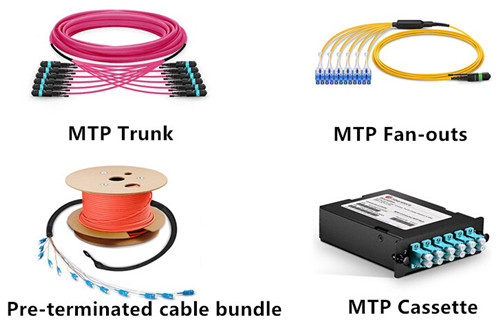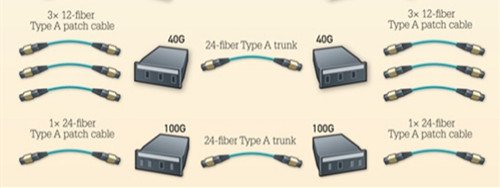As data center of all types continue to grow in terms of traffic and size, 40/100G Ethernet technology is no longer a pipe dream—it is well on the way and set to become the new standard for high bandwidth and intelligent architecture. Faced with this upcoming trend in data center, what preparation should we do? Read this post, and you will get some details.
Normally, there are two interfaces that 40/100G transceivers use: LC and MPO. LC interfaced modules will be used over single mode fiber for long distance data transmission, while MPO interfaced modules are commonly deployed with multimode fiber for short distance. However, there are also some transceivers not following this rule. For example, 40GBase-UNIV uses duplex LC connector, but it only supports 150 meters over OM3 or OM4 fiber, and 500 meters over single-mode fiber as we have mentioned in the previous post. Besides, 100GBase-PSM4 is a single-mode module, but it has MPO interface to achieve data transmission. Choosing LC or MPO interfaced 40/100G transceiver totally relies on the transmission distance that your practical application requires.
| Type | Fiber and Distance | Connector |
| 40GBase-SR4 | 100m(OM3) 150m(OM4) | MPO(male/female) |
| 40GBase-LR4 | 10km(SMF) | Duplex LC |
| 40GBase-UNIV | 150m(OM3) 150m(OM4) 500m(SMF) | Duplex LC |
| 100GBase-SR4 | 100m(OM3) 150m(OM4) | MPO (male/female) |
| 100GBase-LR4 | 10km(SMF) | Duplex LC |
| 100GBase-PSM4 | 500m(SMF) | MPO (male/female) |
Cost is always the most important factor that every IT managers and ordinary users will concern. Since the technology for 40G and 100G is not as mature as 10G, devices used in these high-speed networks are more expensive, so we should keep our budget down as possible as we can in every aspect in the process of 40/100G migration. Then pre-terminated cabling system is a good choice.

Pre-terminated cabling system contains factory manufactured cables and modular components with connectors already attached. It comes in a number of different forms, from connectorized fan-outs and attached or discreet cassette modules to cable bundles utilizing both fiber and copper with protective pulling grips installed over the connectors at one end. With these pre-terminated cabling, the need for labor to make terminations on site will be mitigated. And fewer labor means more savings on the labor bill. As report indicates, using the pre-terminated approach can achieve a saving of 57 percent.
| Punch Down Solution | Pre-terminated Cabling | |
| Material Cost | 1X | 3.2X |
| Labor Cost | 2X | 1X |
| Total | 1X | 1.3X |
| Installation Time | 10 Hrs | 5 Hrs |
In many 40/100G cases, 12-fiber system is more recommended to use between core switched and the equipment distribution area in the data center, but actually, if you want to future-proof your network, try 24-fiber infrastructure. Why? Let’s have a quick comparison.
For typically 40GbE applications, the 4 right and 4 left fibers of a 12 fiber MPO connector are used for transmit and receive while the inner 4 fibers are left unused. For 24-fiber 40GbE application, all fibers are utilized in the MPO plug. 24 fibers, divided by the 8 fibers per circuit that are required, yields 3 full 40GbE connectors. For 100GbE applications, if we choose 12-fiber MPO connector, we need two connector and two MPO trunk cables, the middle 20 fibers are used for transmit and receive 10Gb/s while the 2 fibers on the right are left unused. However, in this case, we just need one MPO 24 connector and one 24f trunk cable. As data centers continue to be crowded with more cabling, with 24-fiber system, about 1-1/2 times more pathway space could be saved.

With the rapid increase in bandwidth consumption, the migration from 10GbE to 40/100GbE is inevitable. Proper interfaced transceiver, pre-terminated cabling system and 24-fiber infrastructure are required to build a cost-effective and high density 40/100G data center. If you’re interested in the components that we have mentioned above, kindly visit FS.COM.
